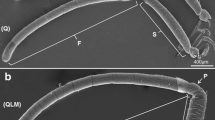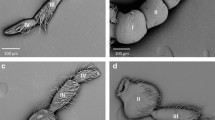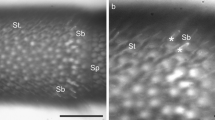Summary
Number and distribution of sensilla and setae on the antennal flagellum of the honeybeeApis mellifera carnica were determined on whole antennal preparations. The following types of sensilla were distinguished according to their cuticular structure: Sensillum placodeum, S. ampullaceum, S. coeloconicum, S. basiconicum, S. campaniforme and 5 hair sensilla S.trichodeum A, B1, B2, C, D, as well as 4 types of probably non-innervated setae (A1–3, B). The names used here for the different types were compared with the previously used terms. Number and distribution of sensilla, the number of sensory cells and the function of the sensilla were discussed with respect to the data available from the literature. There is a notable dimorphism between the worker and drone with respect to the relative number of sensilla of each type and to the total number of sensory cells. The worker has far more of the presumably olfactory S. trichodea A and of the mechanoreceptive S. trichodea B1. The drone lacks the S. basiconica and has far more S. placodea than the worker. The flagellum surfarce of the drone is twice as large as that of the worker and has 5 times as many sensory cells. The worker flagellum has a poreplate-free zone on the side facing the head which is densely packed with non-innervated setae. In the corresponding zone the drone has a lower density of poreplates than elsewhere on its antennal flagellum. All other sensilla and setae are also characteristically distributed.
Zusammenfassung
An Totalpräparaten der Antennengeißel von Arbeiterin und Drohne vonApis mellifera carnica wurden Zahl und Verteilung aller Sensillen und Setae ermittelt. Dabei ließen sich anhand des cuticularen Baues folgende Sensillentypen unterscheiden: S. placodeum, S. ampullaceum, S. coeloconicum, S. campaniforme und 5 Haarsensillen S. trichodeum A, B1, B2, C, D, sowie 4 Setatypen (A 1–3, B), die wahrscheinlich nicht innerviert sind. Die Benennungen der Sensillen wurde den bisher gebrauchten Bezeichnungen gegenübergestellt. Sensillenzahl und -Verteilung, Sinneszellzahl und Funktion der Sensillen wurden anhand von Literaturangaben zusammengestellt und diskutiert. Bemerkenswert ist der starke Dimorphismus zwischen Arbeiterin und Drohne in der relativen Sensillenzahl für die einzelnen Sensillentypen und in der Gesamtzahl der Sinneszellen. So sind bei der Arbeiterin die wahrscheinlich olfaktorischen S. trichodea A und die mechanorezeptorischen S. trichodea B 1 wesentlich stärker vertreten. Die Drohne hat keine S. basiconica und im übrigen wesentlich mehr S. placodea als die Arbeiterin. Insgesamt hat die Drohne eine ca. 2-fach größere Geißeloberfläche und etwa 5-mal soviele Sinneszellen wie die Arbeiterin. Die Arbeiterinnengeißel hat auf ihrer Rückseite eine porenplattenfreie Zone, die dicht mit nichtinnervierten Setae besetzt ist. Bei der Drohne findet man stattdessen eine porenplattenärmere Zone mit einer geringeren Zahl von Setae. Charakteristische Verteilungsmuster bestehen auch für alle anderen Sensillen und Setae.
Similar content being viewed by others
Literatur
Boeckh, J.: Die Reaktionen olfaktorischer Neurone im Deutocerebrum von Insekten im Vergleich zu Antwortmustern der Geruchssinneszellen. J. comp. Physiol.90, 183–205 (1974)
Dietz, A., Humphreys, W.J.: Scanning elektron microscopic studies of antennal receptors of the worker honeybee, including sensilla campaniformia. Annals of the Entomological Society of America64, No. 4(1971)
Dostal, B.: Riechfähigkeit und Zahl der Riechsinneselemente bei der Honigbiene. Z. vergl. Physiol.41, 179–203 (1958)
Forel, A.: Das Sinnesleben der Insekten. München: Reinhardt 1910
v. Frisch, K: Tanzsprache und Orientierung der Bienen. Berlin-Göttingen-Heidelberg: Springer 1965
Kafka, W.A., Ohloff, G., Schneider, D., Vareschi, E.: Olfactory discrimination of two enantiomers of 4-methyl-hexanoic acid by the migratory locust and the honeybee. J, comp. Physiol.87, 277–284 (1973)
Kaissling, K.-E.: Insect olfaction. In: Handbook of sensory physiology, Vol. IV (L. M. Beidler, ed.) pp. 351–431. Berlin-Heidelberg-New York: Springer 1971
Kaissling, K.E., Renner, M.: Antennale Rezeptoren für Queen-Substance und Sterzelduft der Honigbiene. Z. vergl. Physiol.59, 357–361 (1968)
Kraepelin, C.: Die Geruchsorgane der Gliedertiere. Osterprogramm des Johanneums, Hamburg (1883)
Krause, B.: Elektronenmikroskopische Untersuchungen an den Plattensensillen des Insektenfühlers. Zool. Beitr. N. F.6, 161–205 (1960)
Kunze, G.: Einige Versuche über den Antennengeschmackssinn der Honigbiene. Zool. Jb. (Physiol.)52, 465–512 (1933)
Kuwabara, M., Takeda, K.: On the hygroreceptor of the honeybee,Apis mellifica. Physiol. and Ecol.7, 1–6 (1956)
Lacher, V.: Elektrophysiologische Untersuchungen an einzelnen Rezeptoren für Geruch, Kohlen-dioxid, Luftfeuchtigkeit und Temperatur auf den Antennen der Arbeitsbiene und der Drohne (Apis mellifica L.). Z. vergl. Physiol.48, 587–623 (1964)
Lacher, V., Schneider, D.: Elektrophysiologischer Nachweis der Riechfunktion von Porenplatten (Sensilla placodea) auf den Antennen der Drohne und der Arbeitsbiene (Apis mellifera L.). Z. vergl. Physiol.47, 274–278 (1963)
Leydig, F.: Die Hautsinnesorgane der Arthropoden. Zool. Anz.9, 284–291 (1886)
Martin, H.: Leistungen des topochemischen Sinnes bei der Honigbiene. Z. vergl. Physiol.50, 254–292 (1965)
Martin, H., Lindauer, M.: Sinnesphysiologische Leistungen beim Wabenbau der Honigbiene. Z. vergl. Physiol.53, 372–404 (1966)
Me Indoo, N.E.: The auditory sense of the honeybee. J. Comp. NeuroL34, 173–199 (1922)
Minnich, D.E.: The contact chemoreceptors of the honeybeeApis mellifera L. J. exp. Zool.61, 375–393 (1932)
Ruland, F.: Beiträge zur Kenntnis der antennalen Sinnesorgane der Insekten. Z. wiss. Zool.46, 602–628 (1888)
Ruttner, F., Kaissling, K.E.: Über die interspezifische Wirkung des Sexuallockstoffs vonApis mellifica und Apis cerana. Z. vergl. Physiol.59, 362–370 (1968)
Schenk, O.: Die antennalen Hautsinnesorgane einiger Lepidopteren und Hymenopteren mit besonderer Berücksichtigung der sexuellen Unterschiede. Zool. Jb., Abt. Anat. u. Ontog.17, 573–618 (1903)
Schneider, D., Steinbrecht, A.: Checklist of insect olfactory sensilla. Symp. zool. Lond. No.23, 279–297 (1968)
Skirkevicius, A., Buda, V.: The arrangement of plate organs on the antennae of worker bee (Apis mellifica L.) and its possible role in olfactory orientation, pp. 85–93. In: Insect Chemoreception No. 2. Vilnius 1975
Slifer, E., Sekhon, S.S.: Fine structure of the sense organs on the antennal flagellum of the honey-bee,Apis mellifera L. J. Morph.109, 351–381 (1961)
Stange, E.: The influence of a carbonic anhydrase inhibitor on the function of the honeybee antennal CO2-receptors. J. comp. Physiol.91, 147–159 (1974)
Stange, E., Diesendorf, M.: The response of the honeybee antennal CO2-receptor to N2O and Xe. J. comp. Physiol.86, 193–158 (1973)
Vareschi, E.: Duftunterscheidung bei dei Honigbiene-Einzelzellableitungen und Veihaltens-reaktionen. Z. vergl. Physiol.75, 143–173 (1971)
Vareschi, E.: Single cell response and odor-discrimination in thehoneybee, pp. 187–192. In: Olfaction and taste, Vol. IV (D. Schneider, ed.). Stuttgart: Wissenschaftl. Verl.-Ges. 1972
Vogel, R.: Zur Kenntnis des feineren Baues der Geruchsorgane der Wespen und Bienen. Z. wiss. Zool.120, 281–324 (1923)
Wacker, F.: Beiträge zur Kenntnis der antennalen Sinnesorgane der Hymenopteren. Z. Morph. u. Oekol. Tiere4, 739 (1925)
Witthöft, W.: Absolute Anzahl und Verteilung der Zellen im Hirn der Honigbiene. Z. Morph. Tiere61, 160–184 (1967)
Author information
Authors and Affiliations
Rights and permissions
About this article
Cite this article
Esslen, J., Kaissling, KE. Zahl und Verteilung antennaler Sensillen bei der Honigbiene (Apis mellifera L.). Zoomorphologie 83, 227–251 (1976). https://doi.org/10.1007/BF00993511
Received:
Issue Date:
DOI: https://doi.org/10.1007/BF00993511




